Our SouthEast Asia Trip
link to YouTube video of our slides:
| https://www.youtube.com/watch?v=8-AZ9bk_XM8 |
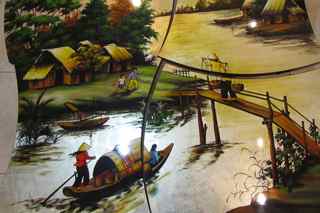
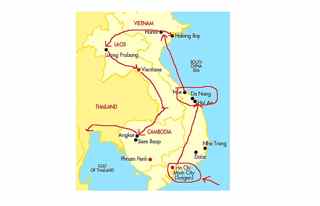
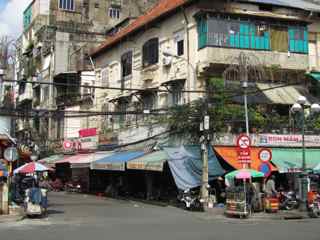
Message 1
We made it here in 1 piece but a bit sore from 24+ hours of air travel. It is nice to get off the plane and see a guide with our name on a board to collect us and whisk us away. Our hotel in Saigon was near the river and in the heart of the downtown district. Yesterday we crawled through the Cu Chi tunnels at the end of the old Ho Chi Minh Trail near the border of Cambodia. Today we flew to Da Nang and drove along China Beach to Hoi Ann. Hoi Ann is an older city that has been preserved well. Everyone has been very friendly --
Tomorrow we will drive north to Hue and tour the old city center.
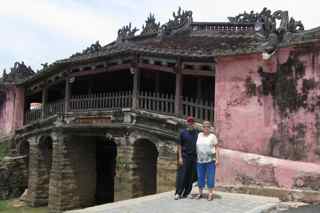
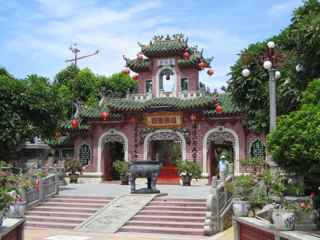
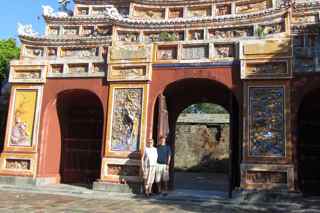
Saigon has 9 million people and everyone seems to have a moped. It is even a challenge to cross the streets sometimes. It is a nice change of pace to be out of the city now.
Message 2
Hi from Hanoi
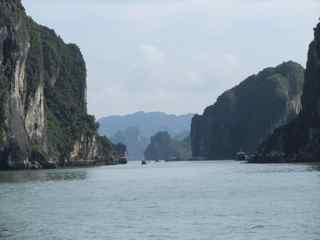
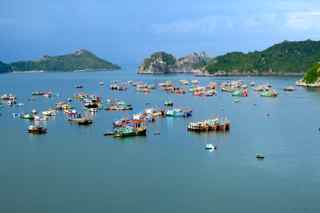
The last few days have been busy. We toured from Hoi An to DaNang along China Beach. Then over a mountain pass to Hue. Hue was the site of the Imperial Palace and we spent time in the old city seeing the Kings palaces. Our hotel was an old French Mansion, right across from he Imperial City on the Perfume River. Then we took a boat ride to see sever5al of the imperial tombs.
An hour flight got us to to Hanoi and immediately drove 3 hrs to Halong Bay. Had our own private junk to sail through the most amazing limestone formations and we ended up on a large island with a national park, Cat Ba. Our hotel here was basic but our room was on the 12th floor and we had a great view of the bay. IN the morning I took a hike with our guide in the national park to the top of the islands tallest peak.. In the US, this hike would have been rated "scary", really steep, lots of exposure and slick footing. All of this with an approaching thunderstorm. But the views were great from the top.
Today we took the hydrofoil to Haiphong and then drove 2 hrs to Hanoi. Driving around here is exhausting, even as a passenger. Kind of like a full contact sport. Not enough roads and the few roads that exist have way too many little motor scooters zipping around, in a chaotic fashion seeming to follow NO traffic laws.. As a former NY cab driver I dont think I am brave enough to drive around here.
So far, each hotel has cable TV with CNN and ESPN as well as some level of internet service. Even as we drive through the small villages, people have satellite dishes on the roof. Our guides all have had some college and speak English well. They are very computer literate and know about facebook and twitter. EVERYONE has a cell phone. We have seen 4 people riding on a motor scooter built for 2 with a person using the cell phone , sometimes even the driver is talking on the cell phone. and they all seem to have smart phones!Today, Bette was able to connect to the hotel WIFI with her Kindle and download a book from Amazon. Did not take more than 30 seconds.
We have not met many other travelers. It is off season (hot!!!) and the world economy is affecting tourism still. The few that we meet are mostly young back packers from Europe. The good thing is nothing has been very crowded.
Prices are reasonable. You can get meals for $4 or less. Beer is only about $1.50 and bottled water is under a $1. We have seen signs for massages for $3. An hour cyclo ride is only a dollar or two. Gas is about $3.50 per gallon.
Several area that we have visited are rapidly developing into future world class resorts: Hoi An (China Beach) and Cat Ba Island (they are building a massive resort on the island).
Tomorrow we tour Hanoi and then have a day on our own to wander the streets of Hanoi before heading to Laos. I have a feeling internet access will not be readily available in Laos.
It has been very nice to get off the plane and see someone holding a sign with our names saying--follow us!!
I have taken about 1 zillion pictures so be prepared...........................
Until next time --
--
Message 3
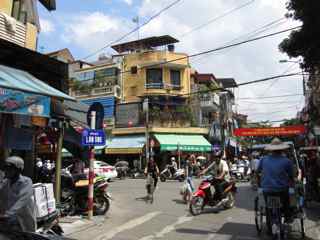
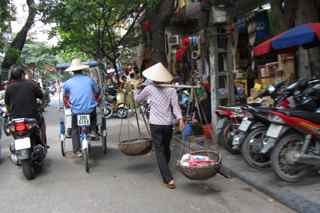
Answering some questions:
What you haven't spoken about at all is what kind of "legacy" we've left there. Any vestiges of the war that are obvious. What about the people, do they mention it? Or have they just moved on?
The question people ask me is, "Have I been here before?", as I am the correct age to have been here '68-'73. In the south the guides wanted to take us to the war museum, tunnels, etc. They made a point of mentioning that they think people supported Ho Chi Minh because almost everyone was living in poverty kind of like a serf, giving most of their money to the landlord who owned the land they were farming. ALso the country has a long history of occupation" the Chinese, then the French.The history suggested they wanted out from all of this as opposed to believing in an ideology of socialism/communism.
Most people are young and were born after the war. There seems to be little after effects in attitude about the war and Americans. But remember, we have been dealing with people who are in the tourist business and they are working for tips. In the north, the attitude seems more business like. Many less people seem to know english. ALso, the money from the government seems to go more to the north in that the roads seem better. This year is the 1,000 year anniversary of Hanoi--it is a big deal here. The country was settled from north to south. So Saigon is only about 300 years old.
What about their religious life - do you see many temples, monks, etc?
The predominant religion is Buddhist and there are some temples but very little signs of active religious observance. In the Hue area, the center of the French occupation, there were several churches. People seem to be free to worship as they please. The rules about moving about and setting up a business have loosened alot. There are many forms of capitalism and little businesses everywhere that people own. The big business and investments are a combination of government owned with outside investments, mostly Japanese.
Are there many homeless and do they approach you for a handout everywhere - or is everyone seemingly getting by?
Most people in the city seem to be LOWER middle class-meaning they have a place to live, a job, a TV, and of course, a motor scooter. Not much begging that we have seen.
Are you enjoying the food? How spicy is it? We tend to be kind of conservative in what we eat-lots of fried rice, noodles and vegetables. Easy to avoid some of the real spicy stuff that they place in front of us. And we have passed on the chance to enjoy frog and duck embryos!
Are there any obvious problems with drug abuse?
None that we have seen.
This morning I wandered just around the block of our hotel in Hanoi. Just doing a 1 block circuit was almost overwhelming. The traffic is crazy. I have a pretty good sense of direction and the streets are not square. It was not easy finding the hotel just going around the block!
Off to tour the city and later on see a performance of the water puppets.
--
Message 4
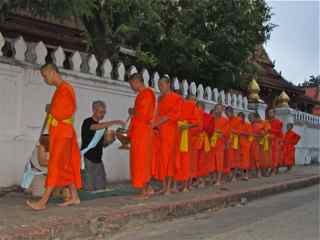
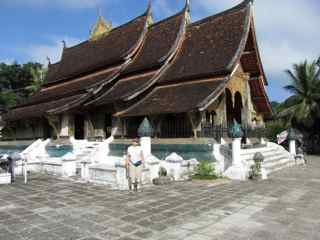
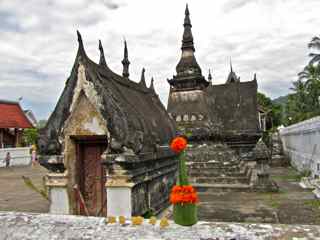
Hi from the Million Elephant Kingdom
This is a VERY amazing place. Very different from Vietnam. Laos has only 5 million people compared to the 90 million in Vietna. The average wage here is less than $1,000/yr. No traffic, hardly any scooters to dodge. Luang Prabang is a city that has retained much of its historical cultural sites, look and feel. It was the original capital city with 100's of Wats (temples). They really take Buddhism seriously here. It is part of everyday life. Our hotel was right in the heart of the city. At 4 am, I thought we were under attack but it turned out to just be the temple next door beating the wakeup drums for the novice monks. We went out to the streets and joined the locals as they offered alms (rice) to the monks at 5:30 am. They do this everyday.
The city is a peninsula with The Mekong River on one side and the xxx-forget the name river on the other side. We took a slow boat about 2 hours upriver visiting several villages along the way to a cave shrine.
Laos was a monarchy until about the 1600's. Siam and Laos had a big war and Laos lost and it became part of Siam (Thailand). When the French came into the area , 1890's, they told Siam to give them the Laos land east of the Mekong or they would invade. The French then reinstalled the Laos Monarchy. Until the Japanese took the land during WWII. The French reoccupied after the war but after the battle at Diem Bien Phu in Vietnam, the French pretty much left indochina and the monarchy had full control until 1975. Then the pathet Lao (Communist party) took the country and re-educated the King. It now operates as the People Democratic Republic, but not very democratic as it is a one part system (communist party). But, the people seem to do what they want and over the last 20 years, all policies are becoming more liberal and entrepreneurial. Tourism has also become more prevalent since the late '80's. But still, there are NOT many tourists compared tp the other southeast asian countries.
Luang Prabang is a fragile place and it is hard to think of it remaining the same as tourism increases. Also, eco-tourism is really starting to take off with hiking trips as well as kayaking the Mekong.
Had a great dinner last night in a french restaurant.
This morning we had a flight to Vientiane, the capital city. A brief tour of the city revealed some fabulous stuppas and a quite, unhurried city for a large capital. Ventiane is in the lowlands compared to the mountainious region around Luang Prabang. Tonight we have dinner and a cultural show!!
Tomorrow we finally head to Cambodia and Angor Wat.
Until next time
--
Barry
Message 5
Hi
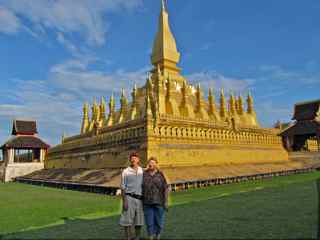
Laos is still suffering from the constant bombing from '64-''73. According to the stats, more bombs were dropped on this country than what was used on Europe during WWII. The problem now is LOTS of unexploded ordinance. IN spite of all of that, the people are incredibly friendly. Tourism is a major source of income but NOT many visit from the US. In fact, only 40,000 visited last year . More come from Europe and lots from Asia, especially Thailand.
In VIENTIANE we were treated to a beautiful dance show. The hand movements of the dancer was incredible. I got some video of her movements but I dont know if it will show just how graceful she was.
The minority populations in Laos seem to be treated as an equal part of the country compared to in Vietnam where they are looked down upon.
I have lost count of the number of Wats and Stupas we have seen. Every village has several. As we traveled from the mountainous region to the lowlands it got even greener with ride paddies everywhere. The Mekong River defines the border for much of the country on the west between China, Myanmar, Thailand and Cambodia before emptying into the Vietnam delta Later today we start our tour of Cambodia and Angkor Waht.
I have taken about 2 zillion pictures of course!!
UNtil next time..............
--
Barry.
Message 6
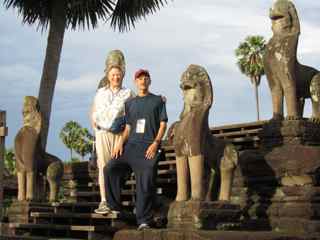
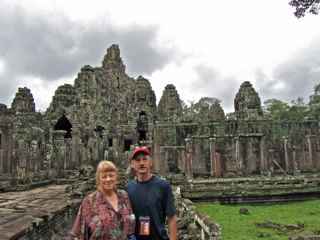
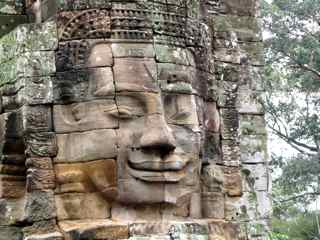
We are staying in Siem Reap, a town just outside of the Angkor Wat complex. The town has been built to accommodate the tourists during the last 10 years. We spent the afternoon exploring Angkor Wat, the largest temple in the complex from about 2 pm to sunset. It is enormous. It dates from the 10th century, built by the Khmer people, who are probably originally from northern India. The temples were built as Hindu Temples and this area, at its peak was one of the largest cities in the world. For its age and considering how poorly it has been guarded through constant wars and extreme poverty, it is still an amazing site with much intact and many bas-relief sculptures covering the walls depicting Hindu legends. Our guide is very knowledgeable and has been explaining many of the legends to us.
We timed the visit to stay for sunset and the colors as they changed on the Wat walls was beautiful.
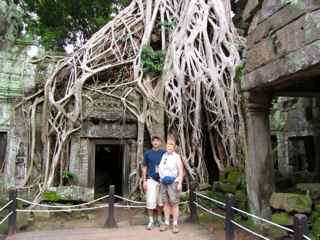
Cambodia, as the previous countries we have visited, has been scared by constant occupation, war and poverty. The Khymer culture was defeated when the Kingdom of Siam occupied the entire south east asia region in the 1500's. It was part of Siam until the French and British moved into the area and divided the area in the late 1800's, INdia and Burma going to the Brits and Cambodia, Laos and Vietnam to the French as IndoChina. Siam became Thailand, as a buffer between the 2 colonial giants. WWI saw the Japanese occupy the area but after the war, the French moved back in until the early 70's. About 1975 the Khymer Rouge communists (Pol Pot) staged a civil war and ruled the country for about 15 years with a brutal history of re-educating and killing almost 2 million people. Our guide was telling us during this time his mother, father, brother and sister all died. He is the only family survivor from the civil war and subsequent starvation that so many experienced. it is very sad that the entire rest of the world stood by and did virtually nothing during this time. (No oil here so we have no interests).
We have traveled in the past to Thailand and there is a distinct history, culture and architecture there. We have noticed throughout SouthEast Asia, the history and architecture and even culture gets kind of muddled due to constant outside occupation and war. Thailand did not experience the same fate and it is the most prosperous country in the region (but they are having there own political problems now).
Cambodia is very poor, with the average income about $2,000/yr. Not as many cars or scooters as Vietnam. We are in a tourist area so people here have jobs. According to our guide, 90% of people work in agriculture, cannot afford medical care but most seem to get at least some education and can read/write.
The language and writing is different in all three countries we have visited.
People here continue the tradition of being very friendly to us. The civil war (Pol Pot) is more on their mind than the bombing we did along the Ho ChiMinh trail on their border. The political situation here seems pretty open. Our guide says there are elections and at least 10 political parties. The locals are informed of the world news through the internet and CNN on Satellite TV. I have not noticed clothing looking much different than what I wear. The food is similar to the other countries we have visited but with some distinct spices. Here they do not give us chop sticks while in Vietnam that was all you got unless you asked for a fork.
Today we explore more areas of Angkor Wat and end the day with a dinner and cultural show. Having this private guide service is really spoiling us. We do not have to make any decision, just follow them. They even check us into the hotels and wait in line at the airport for us!!! I can get real used to this treatment.
Stomach wise we have stayed healthy, bottled water and beer works to cure all. Bette picked up a nasty respiratory infection but seems to be recovering after a week of coughing and sneezing. The local pharmacy in Hanoi gave us meds that we kind of recognized.
Until next time
--
Barry
Message 7
Hi
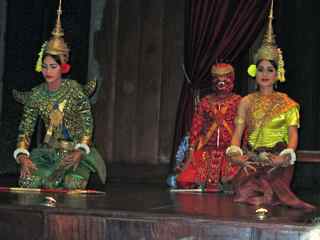
We have seen MANY Wats now and each one has something spectacular. Hard to believe that anything survives considering that this land has been through.
Last night we saw a performance of the Apsara traditional dance. Another one with the crazy finger movements. I read the brochure and it seems that they start stretching fingers and expanding joint connections when they are very young. Some of the video I have is unbelievable of what the fingers do.
This evening we toured a floating village in the largest Cambodian Lake. The poverty and filth takes your breathe away that people can live like this. Once you get outside of the tourist areas, you see how poor the country is.
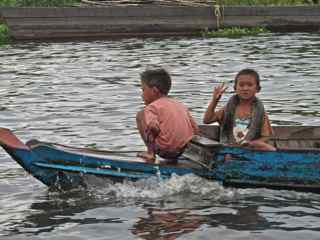
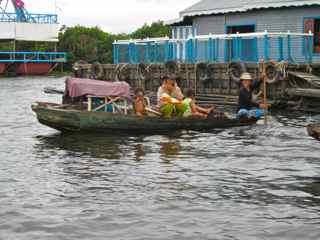
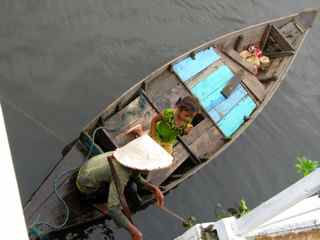
We are now in the airport starting the LOOOOOOOOOOOOOOOOOOONG way home. Scotty please just beam us up!!!!
Tonight we are in Bangkok then tomorrow early we fly to Tokyo and then another flight to Seattle and then Denver. About 24+ hours.
Until we are home---signing off.
--
Barry
Final Message
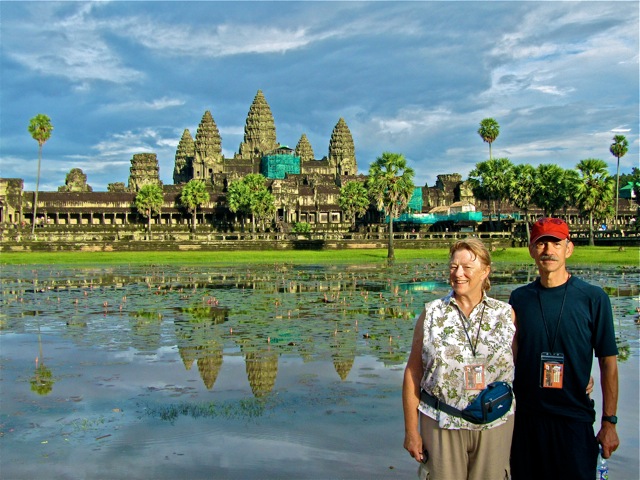
Until our next trip-----PEACE!!!!!!!!!!!